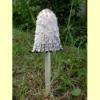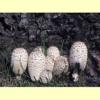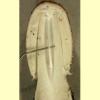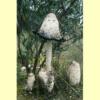
images/Coprinus_comatus_group/Coprinus_comatusMD.jpg
Medium to large agaric, growing on the ground or dung, with a black spore print. Pileus white, pale, brown, purple or grey, often very parabolic when young, not viscid. Lamellae free. Stipe central. Partial veil remnants a membranous annulus. Fruit-body deliquescent. Spores yellow-brown, reddish brown, brown or black, smooth; germ pore broad. Cheilocystidia present; pleurocystidia absent. Lamellar trama regular to interwoven with age. Pileipellis a cutis; pileocystidia absent. Clamp connections present or absent.
Coprinus in the strict sense differs from those species formerly included in the genus, but now placed in
Coprinellus,
Coprinopsis and
Parasola, by the combination of large fruit-body size, squamulose pileus (with the scales not easily dislodged), the presence of an annulus (often low down on the stipe at maturity), the absence of pleurocystidia and in having a pileipellis that is a cutis, without pileocystidia. The common species,
C. comatus, is very distinctive, due to the very tall, elongate pileus when young (up to 200 mm high) which is strongly deliquescent. A useful field character for this genus is the presence of a cottony thread inside the hollow stipe, extending from base to apex.
Lacrymaria can have a similarly shaggy pileus, but it is not deliquescent, and the spores are warty.
Coprinus Pers., Tent. Disp. Meth. Fung. 62 (1797).
Three species:
Coprinus comatus,
C. sterquilinus and
C. radicatus (also placed in
Coprinopsis, but seems to fit
Coprinus better).
This is Coprinus in the strict sense, exclusive of the numerous species now placed in Coprinellus, Coprinopsis and Parasola.
Coprinus comatus (O.F.Müll.) Pers., Tent. Disp. Meth. Fung. 62 (1797).
All States and Territories.
In parks, gardens, farms and disturbed areas, such as along roadsides.
On the ground, or on dung or manured soil.
Saprotrophic.
Bougher, N.L. & Syme, K. (1998),
Fungi of Southern Australia. University of Western Australia Press, Nedlands. [
Description,
Illustration and
Microcharacters of
C. comatus]
Breitenbach, J. & Kränzlin, F. (eds) (1995), Fungi of Switzerland. Volume 4. Agarics 2nd part. Edition Mykologia, Lucerne. [Illustration, Description and Microcharacters of C. comatus]
Fuhrer, B. (2005), A Field Guide to Australian Fungi. Bloomings Books, Hawthorn. [Description and Illustration of C. comatus]
Grey, P. & Grey, E. (2005), Fungi Down Under. Fungimap, South Yarra. [Description, Illustration and Map for C. comatus]
Grgurinovic, C.A. (1997a), Larger Fungi of South Australia. The Botanic Gardens of Adelaide and State Herbarium and The Flora and Fauna of South Australia Handbooks Committee, Adelaide. [Description and Microcharacters of C. comatus, C. radicatus and C. sterquilinus, along with Illustration of C. comatus and Key to South Australian species of Coprinus in a broad sense]
McCann, I.R. (2003), Australian Fungi Illustrated. Macdown Productions, Vermont. [Illustration of C. comatus]
Orton, P.D. & Watling, R. (1979), British Fungus Flora. Agarics and Boleti. 2 / Coprinaceae Part 1: Coprinus. Royal Botanic Garden, Edinburgh. [Description, B&W Illustration and Microcharacters of C. comatus and C. sterquilinus, along with Key to British species of Coprinus in the broad sense]
Young, A.M. (2005b), A Field Guide to the Fungi of Australia. University of New South Wales Press, Sydney. [Description and B&W Illustration of C. comatus]






